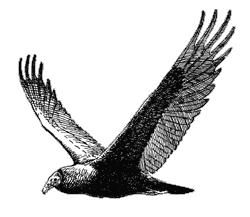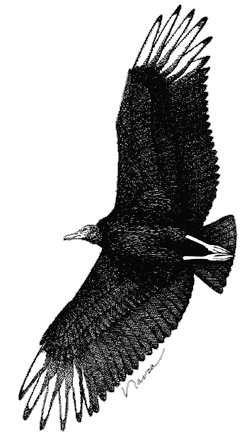Vultures
In cartoon fiction, vultures are ghastly portents of death, circling ominously overhead when explorers are lost in the desert. In reality, vultures play a much more wholesome role. By cleaning up the carcasses of dead animals, they act as the sanitation department of the natural world.
 |
Vultures are perfectly designed for living on carrion. They may have to wait a few days in between meals, so in searching for food they burn up very little energy, soaring for hours with scarcely a flap of their broad wings. Their search is aided by keen eyesight and, in the case of the turkey vulture, a well-developed sense of smell, unusual among birds. And although their naked wrinkled heads may be unattractive to human eyes, the lack of feathers on their heads is a decided advantage when the birds are involved in the messy business of tearing open dead animals.
The vultures found in the warmer parts of Europe, Asia, and Africa are in the same family as are hawks and eagles. The vultures of the Americas come from a totally different background; they are now known to be more closely related to storks. It seems remarkable that these two completely unrelated groups of vultures should be so similar in structure and appearance. The similarities are probably adaptations to the same feeding behavior, an example of what is called convergent evolution.
—Kenn KaufmanSonoran Desert species:
Turkey Vulture (Cathartes aura)
Black Vulture (Coragyps atratus)
Order: Ciconiiformes
Family: Cathartidae (New World Vultures)
Other common names: buzzard (both species)
Spanish names: zopilote, buitre (vulture); aura cabeciroja, aura común
(Turkey Vulture); zopilote común (Black Vulture)
Distinguishing Features
The featherless head and large dark body help to identify these 2 scavengers. In flight they can be distinguished from one another by the patterns of the underside of the wings and by the wing shape. Turkey Vulture: A large dark brown to black bird with a featherless red head; reddish feet; underside of wings appear two-toned; wingspan is up to 6 feet (1.8 m); an accomplished soarer. Black Vulture: A large shiny black bird with a dark gray, featherless head and gray feet; underside of wings have prominent white patch at the tip; tail is short and square; flies with several short wing beats and then a short glide; also soars effortlessly on hot days.
Habitat
Both vultures are found in open country.
Feeding
• Diet: Both are carrion eaters.
 |
• Behavior: The Turkey Vulture hunts by soaring on thermals (rising air currents), sometimes for an hour or more with no apparent movement of the wings; food is located by smell and sight. Turkey Vultures are unusual among birds in that they have a well-developed sense of smell. The Black Vulture finds its food by sight; may watch for concentrations of Turkey Vultures and follow them to carrion.
Life History
Vultures use cliff faces, tree stumps, caves, and hidden areas on the ground for nesting; neither species builds nests. One to 3 whitish, blotched eggs are incubated by both parents; the young are fed by both parents by regurgitation. Turkey Vulture incubation period is 34 to 41 days. Young are capable of flight about 60 to 70 days after hatching. Black Vulture incubation period is 37 to 41 days. Young are capable of flight about 75 to 80 days after hatching.
When threatened, vultures emit a hissing sound in defense; the Black Vulture regurgitates when confronted.
These birds excrete on their legs as a means of cooling themselves. This is called urohydrosis.










